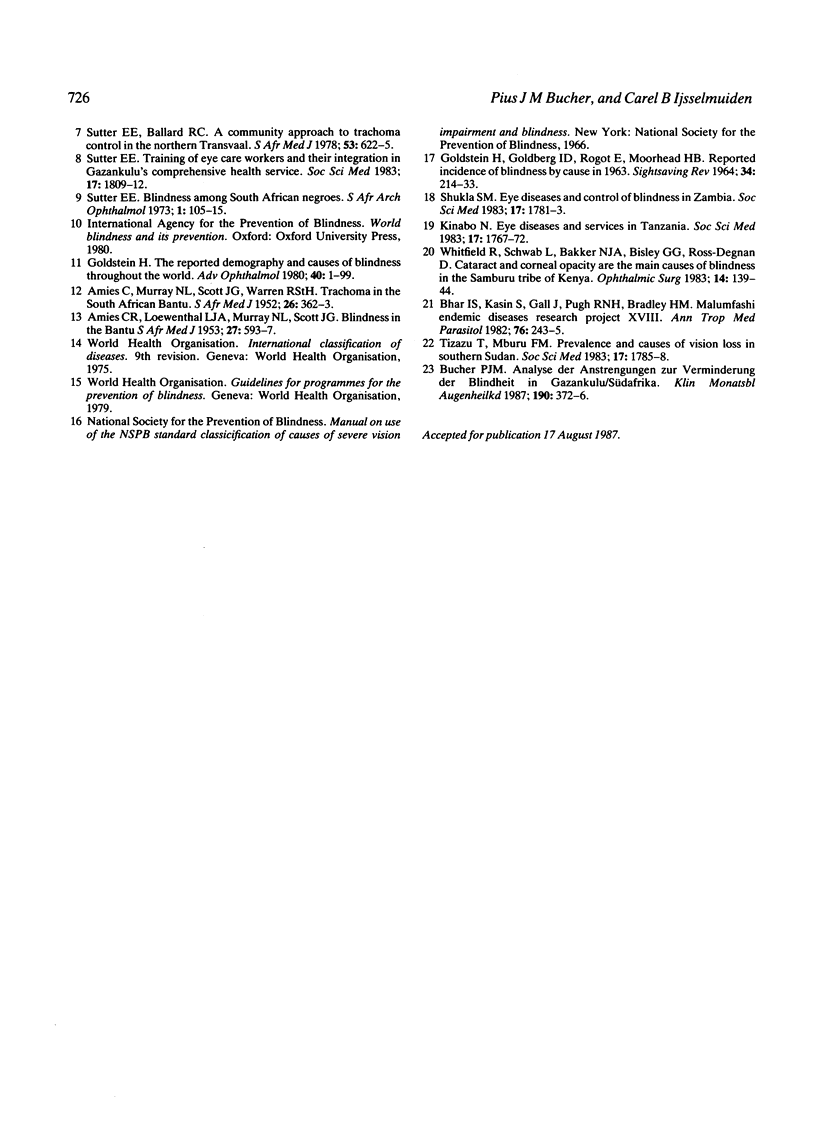Abstract
During November 1985 a survey was carried out to determine the prevalence and causes of blindness in the Elim Hospital district of Gazankulu in the Northern Transvaal, South Africa, and to assess the Eye Department's effectiveness in preventing blindness. Using a random cluster sample technique, we screened 18,962 of the estimated 71,200 inhabitants of the district (26.6%). We found 109 blind people. The prevalence of blindness was 0.57% (95% confidence interval 0.46%-0.68%). The main causes of blindness were senile cataract (55%), corneal scarring due to trachoma (10%), uncorrected aphakia (9%), and open-angle glaucoma (6%). There were 14 aphakic blind persons who did not have aphakia glasses (43% of all persons operated on for cataract). Women had a significantly higher prevalence of blindness than men. After the age of 60 years the prevalence of blindness increased sharply. Women were 1.6 times less likely to have undergone cataract surgery than men. The two most effective steps to reduce the prevalence of blindness in the Elim district further are to provide aphakia glasses to all aphakic patients and to improve the accessibility of the Eye Department's surgical services.
Full text
PDF





Selected References
These references are in PubMed. This may not be the complete list of references from this article.
- AMIES C. R., LOEWENTHAL L. J., MURRAY N. L., SCOTT J. G. Blindness in the Bantu; a survey of external eye disease and malnutrition in the North Eastern Transvaal. S Afr Med J. 1953 Jul 18;27(29):593–597. [PubMed] [Google Scholar]
- AMIES C., MURRAY N. L., SCOTT J. G., WARREN R. S. H. Trachoma in the South African Bantu; a survey in Sekukuniland. S Afr Med J. 1952 Apr 26;26(17):362–363. [PubMed] [Google Scholar]
- Bhar I. S., Kasin S., Gall J., Pugh R. N., Bradley A. K., Moody J. B., Gilles H. M. Malumfashi Endemic Diseases Research Project XVIII. The programme for blindness and ophthalmic disease. Ann Trop Med Parasitol. 1982 Apr;76(2):243–245. doi: 10.1080/00034983.1982.11687536. [DOI] [PubMed] [Google Scholar]
- Goldstein H. The reported demography and causes of blindness throughout the world. Adv Ophthalmol. 1980;40:1–99. [PubMed] [Google Scholar]
- Ijsselmuiden C. B. Nutritional status and blood pressures of adults in northern Gazankulu. S Afr Med J. 1985 May 11;67(19):773–775. [PubMed] [Google Scholar]
- Ijsselmuiden C. B. Nutritional status of children under the age of 5 years in northern Gazankulu. A cross-sectional assessment. S Afr Med J. 1984 Mar 3;65(9):346–347. [PubMed] [Google Scholar]
- Kinabo N. Eye diseases and services in Tanzania. Soc Sci Med. 1983;17(22):1767–1772. doi: 10.1016/0277-9536(83)90389-1. [DOI] [PubMed] [Google Scholar]
- Shukla S. M. Eye diseases and control of blindness in Zambia. Soc Sci Med. 1983;17(22):1781–1783. doi: 10.1016/0277-9536(83)90391-x. [DOI] [PubMed] [Google Scholar]
- Sutter E. E., Ballard R. C. A community approach to trachoma control in the Northern Transvaal. S Afr Med J. 1978 Apr 22;53(16):622–625. [PubMed] [Google Scholar]
- Sutter E. E. Training of eye care workers and their integration in Gazankulu's comprehensive health services. Soc Sci Med. 1983;17(22):1809–1812. doi: 10.1016/0277-9536(83)90396-9. [DOI] [PubMed] [Google Scholar]
- Tizazu T., Mburu F. M. Prevalence and causes of vision loss in southern Sudan. Soc Sci Med. 1983;17(22):1785–1788. doi: 10.1016/0277-9536(83)90392-1. [DOI] [PubMed] [Google Scholar]
- Whitfield R., Jr, Schwab L., Bakker N. J., Bisley G. G., Ross-Degnan D. Cataract and corneal opacity are the main causes of blindness in the Samburu tribe of Kenya. Ophthalmic Surg. 1983 Feb;14(2):139–144. [PubMed] [Google Scholar]


